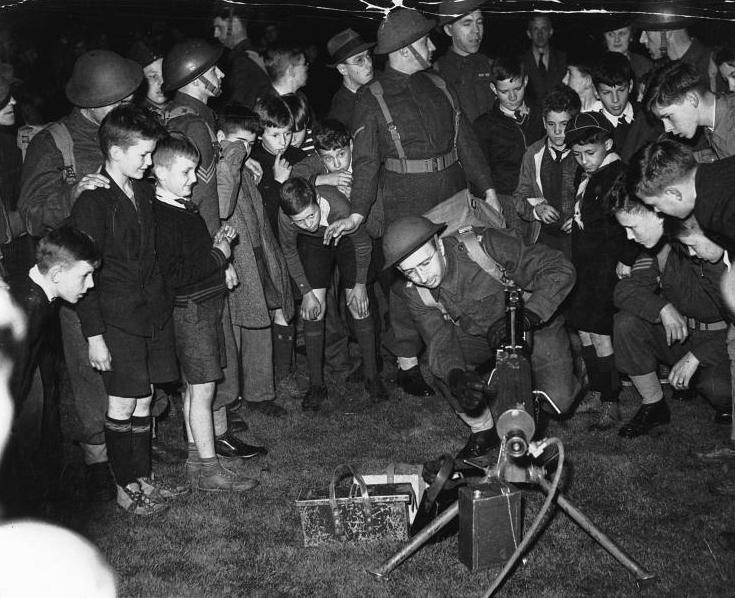
World War II Country Trends: Canada--Industry and Arms Manufacture

Figure 1.--Here Canadian Army soldiers demonstrate a British Vickers World War I era light machine gun before an impressed group of onlookers in Westmount Park, Montreal during 1940. We suspect that most of the boys are English speaking Candians which were more suportive of aiding Britain than French Camndians who were not even very supportive of aiding and then liberating France. Westmount Park is actually in the City of Westmount, Quebec. It is a very prestigious community with deep British roots even today. It is on the Island of Montreal surrounded on the West, East and South by the strongly French City of Montreal and to the North - Mount Royal Park which is a very small mountain (several hundred feet only) with two separate hill tops, one of which is the Westmount Park.
Canada had only a small population of 11 million, it became, however, the four largest Allied manufacturer of arms, after America, the Soviet Union, and Britain. Canada did not develop important weapiobs systems, but it did manufacture munitions, weapons, and eqipment in large quantity.
|
|
Canada unlike the other Dominions had a substantual industrial base. The Canadian contribution began early and made a crucial difference to the winning of the war. For a nation of 11 million people it was an incredible accomplishment, one out of all proportion to its population. The plans to launch another War were laid in Hitler's mind without any careful study. In his ameturish assessment, he failed to appreciate the importance of the Domimions. Canadian industry would make a substantial contribution to the Allied war-effort. The Canadian government after declaring war on Germany (September 1939) took full control of the economy. It rapidly turned it into a vital part of the Allied war effort. And Canadian war plants were safe from Axid bombing. Canada became like America an arsenal of democracy. The country proved to be Britain’s chief overseas supplier of war materiel. America was also a major supplier to Britain, but unlioke America whivh had a much larger military to supply, Canada shipped most of its production to Briatain. The Canadian Federal government set up the Department of Munitions and Supply--DOMAS (April 1940). DOMAS to coordinated the production of munitions for the Canadian armed forces and those of its allies. The Government appointed Clarence Decatur Howe (1886-1960) to head DOMAS. Through DOMAS, Canadian industry not only equipped Canada’s own armed forces but other Allied forces, primarily Britain. DOMAS allocated the available raw materials to war plants and helped created new industries to manufacture needed arms. Canada did not accept American Lend Lease aid, the only Allied nation not to do so. Canada created its own Lend Lease program for its Allies which it called Mutual Aid. The single most important area of production was escort craft for the Royal Canadian Navy. Thanks to a prodigious industrial effort, Canada went from a country without a navy to one of the world's major navies in numbers of ships. This was something Admiral Dönitz had not anticipated. The Royal Canadian Navy thus played a key role in one of the most important battles of the War--the Battle of the Atlantic. The Canadian contribution, however, did not stop here. Many other arms and munitions were manufactured in Canada. Canada was a small, but highly industrialized country. It in particular had a substantial automobile industry which like the American automobile industry could be converted for war production. This had not been the case in World War I, but there was considerable industrial development in the inter-War era. The Canadians supplied its allies C$4 billion dollars worth of war materiel, a much larger figure if calculated in today's dollars. About 70 percebnt of Canaduian production went tom its allies. A further credit of C$1 billion dollars was given to Britain. Canadian industries manufactured war materials with a total value of almost $10 billion - approximately $100 billion in today’s dollars. Canada’s war production was fourth among the Allied nations, only exceeded by that of the United States, the Soviet Union, and the United Kingdom. The Canadians did not develop weapons, but Canadian factories produced weapons developed in Britain and to a lesser extent the United States.
HBC

Navigate the Boys' Historical Clothing Web Site:
[Return to Main Canadian World War II page ]
[Return to Main World War II country industry page]
[Return to Main World War II country technology page]
[Biographies]
[Campaigns]
[Children]
[Countries]
[Deciding factors]
[Diplomacy]
[Geo-political crisis]
[Economics]
[Home front]
[Intelligence]
[POWs]
[Resistance]
[Race]
[Refugees]
[Technology]
[Bibliographies]
[Contributions]
[FAQs]
[Images]
[Links]
[Registration]
[Tools]
[Return to Main World War II page]
[Return to Main war essay page]
Created: 12:58 AM 8/31/2013
Last updated: 12:58 AM 8/31/2013



